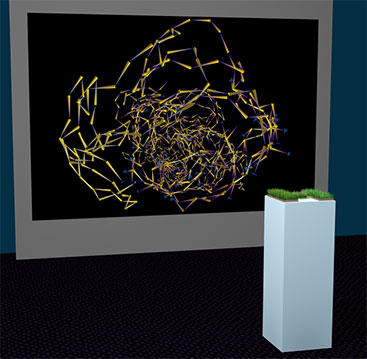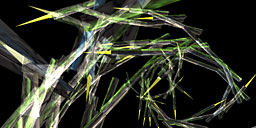 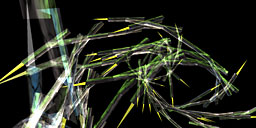 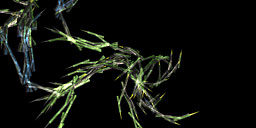 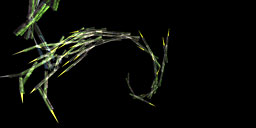 
|
 A series of abstract three-dimensional branching forms created through a custom-designed computational model based on Lindenmayer system theory. Visitors may explore and display each form through a simple touch-sensitive interface.
A series of abstract three-dimensional branching forms created through a custom-designed computational model based on Lindenmayer system theory. Visitors may explore and display each form through a simple touch-sensitive interface.
The six modules. THEMES and MOTIVATIONS |
|
USER EXPERIENCE
Visitors approach a pedestal topped with three neatly trimmed tufts of grass (two rectangles and a circle). On the wall behind the pedestal is a wide screen flat panel display mounted vertically. (In the larger version of this piece, the wall 12 feet in front of the pedestal displays a projected image, at least 6' x 8'.) The image is a jointed branching structure composed of many short polygonal segments, slowly rotating in 3-space. The structure may be in the process of growing branches and generating end-points, or may be fully formed, depending on how long ago other visitors have been present. If visitors do not touch the grass within one minute, the rotating form will begin to contract toward the center of the space and lose some of its saturation. Any touch to any of the three grass segments will cause the form to “un-cringe” and recover its full color and size.
|
 Visitors may touch: •The left grass rectangle, which causes the form to rotate in a positive direction around the Y (up) axis. •The right grass rectangle, which causes the form to rotate in a negative direction. •The center, circular grass segment, which causes the form to suddenly collapse and desaturatue, and disappear. A new form then begins to grow.
The new form may be fully grown in less than a minute, or may take several minutes to fully develop. All the while it will be slowly rotating and gently flexing. Visitors may interact at any time.
Visitors may touch: •The left grass rectangle, which causes the form to rotate in a positive direction around the Y (up) axis. •The right grass rectangle, which causes the form to rotate in a negative direction. •The center, circular grass segment, which causes the form to suddenly collapse and desaturatue, and disappear. A new form then begins to grow.
The new form may be fully grown in less than a minute, or may take several minutes to fully develop. All the while it will be slowly rotating and gently flexing. Visitors may interact at any time.
|
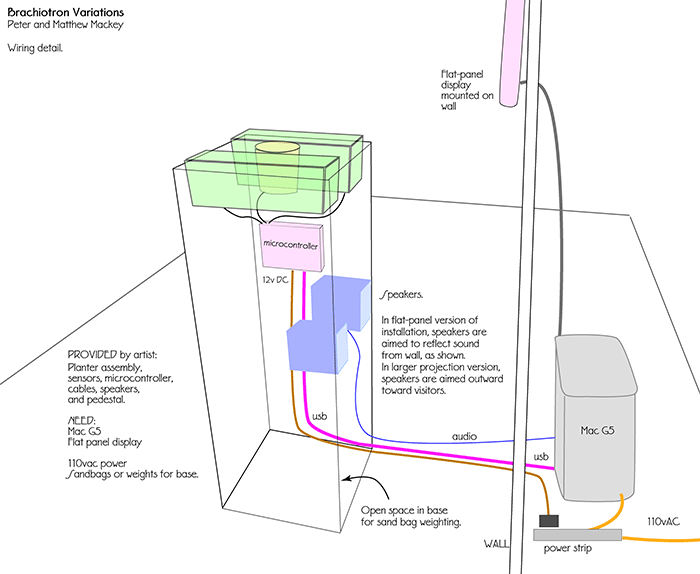
| ABOUT THE ARTISTS Professor Peter Mackey (MFA, Cinema, University of Southern California) is on the full-time faculty in the Department of Digital Arts (formerly Computer Graphics and Interactive Media) at Pratt Institute in Brooklyn, NY. He has been teaching interactive media for twelve years, and producing multimedia projects for nearly 30 years. Matthew Mackey has an MS in Computer Science from the University of Southern California and is currently Senior Software Engineer for The Database Factory in Studio City, CA. Peter previously collaborated on Matthew's Reverse Psycholotron last seen at Burning Man 2005. | FOR MORE ABOUT LINDENMAYER SYSTEMS, see:
An Introduction to Lindenmayer Systems by Gabriela Ochoa.
The Algorithmic Beauty
of Plants by Przemyslaw Prusinkiewicz and Aristid Lindenmayer. The primary source for this topic, richly detailed.
Polygon Gardens by Jerry McManus, a Shockwave 3D implementation. |
